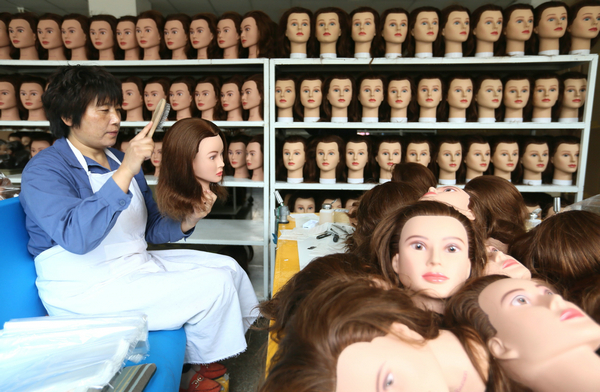 |
|
Fashion influencer Liu Qiang sells wigs via livestreaming in her hometown, a city that bills itself as the wig capital of China, if not the world, Xuchang, in Henan province, Central China. CHINA DAILY |
A Xuchang businessman named Bai Xihe is said to have met one of these German merchants, and the pair opened a joint venture named Dexingyi, equivalent to what today would be a foreign trade company. This small business laid the foundation for Xuchang's wig industry, and 100 years later the town, in the field of hair prosthetics, truly did rule the waves.
The early 20th century happened to be the time when the nationwide braid cutting movement prevailed in the late Qing Dynasty, when braids cut by Chinese men were extremely long, and the Germans used needles to exchange them for huge profits.
In the beginning, Xuchang people simply lopped off hair, but German merchants later provided tools such as wooden combs with which they could refine their activities and taught villagers skills related to processing and preserving hair. After hair was roughly processed, pulled apart, straightened out and tied, it was packed and exported.
In 1933 the local county annals mentioned the standing of the hair trade in the village of Quandian, where it was hugely lucrative.
"I remember that when I was young I would occasionally hear a hawker with a Henan accent yelling 'hair recycling'," says Zhang Jingyi of Beijing, in her early 40s, who had beautiful long hair in her school days that was the envy of her friends.
"When you wanted to sell your hair, you could take out the cut braids. The hawker would look at the length and weigh it. After assessing the hair quality, he would come to a price. Selling hair is similar to selling antiques, and it's a mystery to outsiders how its worth is calculated.
"Later, after living conditions improved, fewer and fewer people gave any thought to selling hair for money. Many young people have never even heard of such thing. In addition, there has been much less space for hawkers since 2000. They're not allowed to enter most communities, there's no way to walk around the streets doing business, and of course you can't collect much hair anyway."
As a result, Xuchang people began to look overseas to collect their raw material of their industry. In Cambodia, Vietnam, Pakistan and Bangladesh, where long hair is cheap, collectors from Xuchang would undoubtedly be active, says Shen Dacheng, a wig factory worker in Xuchang.
Foreign hair is generally 3-5 yuan cheaper per strip than domestic hair, he says.
TianYanCha, a business inquiry platform that is part of the National Small and Medium Enterprises Development Fund, says there are more than 5,000 wig-related companies in Xuchang, many of which export their wares to North America and Africa.
The industry supports more than 300,000 people and supplies half the world's wigs, on average 40,000 being sold every day, it says.
It is reckoned that every two seconds a wig from Xuchang is sold and donned. The cross-border e-commerce transaction volume of Xuchang's hair products was $1.05 billion in 2019, according to the inquiry platform.
zhanglei@chinadaily.com.cn